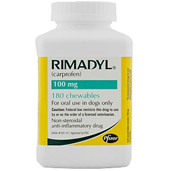If you're the owner of a small or toy dog, you may have seen this exact scene play out before: your dog is running or playing when suddenly they yip in pain, limp for about ten minutes on three legs, and then resumes using their injured limb normally.
What you saw may be caused by what is called luxating patella, which is just the medical term for an out of place or dislocated knee cap.
"If the condition remains untreated, the lameness will worsen and can lead to arthritis in the knee."
What causes a luxating patella?
A groove in the end of the thigh bone (femur) allows the knee cap to move up and down when the knee joint is bent. Your dog's knee cap normally stays in the center of the leg, but in some dogs the patellar ligament (the ligament that runs from the bottom of the knee cap to the bottom of the shin bone) is not attached on the midline of the shin bone.
The force of the thigh muscles (quadriceps) contracting wears down the groove at the end of femur when the patellar ligament is attached too far toward the middle of the body. After months or years of abnormal movements, the groove can wear down, allowing the knee cap to dislocate.
When the knee cap dislocates, it can't go back to its original position until your dog's thigh muscles relax. This is why affected dogs sometimes hold the affected leg up after the initial incident. The pain is caused by the patella sliding across bony ridges on the femur.
What breeds are at risk?
Miniature and toy breeds tend to have the highest incidences of patella luxation. Some of these breeds include: Miniature Poodles, Toy Poodles, Basset Hounds, and Dachshunds.
What are the symptoms of luxating patella?
Dogs affected with luxating patella will show intermittent lameness in the affected limbs. As described above, the dog will usually cry out in pain while running and be able to flex their leg back into its normal position for a while.
Are there long-term risks?
Some pets are able to live with the occasional lameness for many years. The joints are naturally covered in lubricating synovial fluid, so there is usually little or no discomfort early on. But if the condition remains untreated, the groove holding the patella in place can become shallower and the lameness will worsen. Also, patella luxation can lead to permanent arthritis in the knee joint as the dog ages.
What are the treatment options?
Medical treatments and medications can't correct patella luxation because it is caused by a structural abnormality in your dog's knee joint.

Surgery is not necessary in every individual, but it is usually the treatment of choice. The groove can be deepened to better keep the knee cap in place. Or the patella can be "tied down" to keep it from moving to the inside of the leg. A third option to move the site of attachment of the quadriceps tendon on the shin bone. The type of surgery performed depends on the individual dog and the surgeon doing the procedure.
After surgery, most dogs respond quickly and recover completely within 30 to 60 days. After having surgery to correct a luxating patella, many animals lead normal lives without any hindrances on their mobility or activity. Some veterinarians may prescribe NSAIDs like Rimadyl to help treat post-operative pain while your pet recovers.
The above is provided for information purposes only and should not be used for the diagnosis or treatment of any condition.
This information does not cover all possible variables, conditions, reactions, or risks relating to any topic, medication, or product and should not
be considered complete. Certain products or medications may have risks and you should always consult your local veterinarian concerning the treatment of
your pet. Any trademarks are the property of their respective owners.